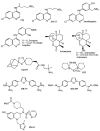Drug discovery for malaria: a very challenging and timely endeavor
- PMID: 17761335
- PMCID: PMC1993815
- DOI: 10.1016/j.cbpa.2007.05.038
Drug discovery for malaria: a very challenging and timely endeavor
Abstract
The prevalence of resistance to known antimalarial drugs has resulted in the expansion of antimalarial drug discovery efforts. Academic and nonprofit institutions are partnering with the pharmaceutical industry to develop new antimalarial drugs. Several new antimalarial agents are undergoing clinical trials, mainly those resurrected from previous antimalarial drug discovery programs. Novel antimalarials are being advanced through the drug development process, of course, with the anticipated high failure rate typical of drug discovery. Many of these are summarized in this review. Mechanisms for funding antimalarial drug discovery and genomic information to aid drug target selection have never been better. It remains to be seen whether ongoing efforts will be sufficient for reducing malaria burden in the developing world.
Figures



References
-
- Nwaka S, Hudson A. Innovative lead discovery strategies for tropical diseases. Nat Rev Drug Discov. 2006;5:941–955. • This is a recent review article that talks about various aspects of drug development for neglected tropical diseases including the special requirement for a low cost of goods and the unusual mechanisms for funding projects. - PubMed
-
- Nallan L, Bauer KD, Bendale P, Rivas K, Yokoyama K, Horney CP, Pendyala PR, Floyd D, Lombardo LJ, Williams DK, et al. Protein Farnesyltransferase Inhibitors Exhibit Potent Antimalarial Activity. J Med Chem. 2005;48:3704–3713. • This article is a nice example of the “piggy back” drug discovery method. - PubMed
Publication types
MeSH terms
Substances
Grants and funding
LinkOut - more resources
Full Text Sources
Other Literature Sources
Medical

